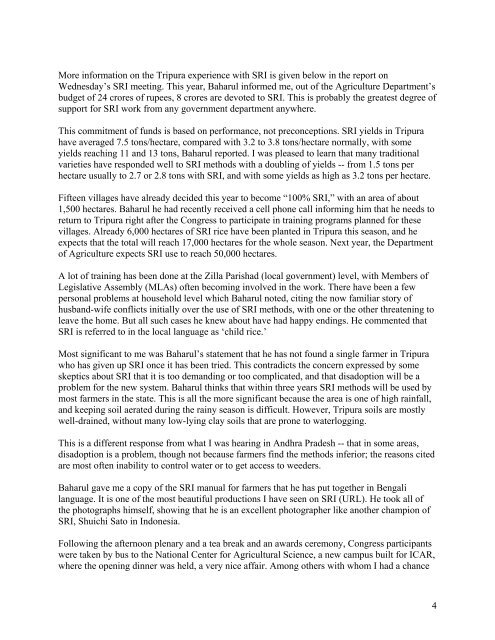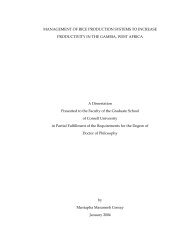REPORT FROM 2ND INTERNATIONAL RICE CONGRESS, NEW ...
REPORT FROM 2ND INTERNATIONAL RICE CONGRESS, NEW ...
REPORT FROM 2ND INTERNATIONAL RICE CONGRESS, NEW ...
You also want an ePaper? Increase the reach of your titles
YUMPU automatically turns print PDFs into web optimized ePapers that Google loves.
More information on the Tripura experience with SRI is given below in the report on<br />
Wednesday’s SRI meeting. This year, Baharul informed me, out of the Agriculture Department’s<br />
budget of 24 crores of rupees, 8 crores are devoted to SRI. This is probably the greatest degree of<br />
support for SRI work from any government department anywhere.<br />
This commitment of funds is based on performance, not preconceptions. SRI yields in Tripura<br />
have averaged 7.5 tons/hectare, compared with 3.2 to 3.8 tons/hectare normally, with some<br />
yields reaching 11 and 13 tons, Baharul reported. I was pleased to learn that many traditional<br />
varieties have responded well to SRI methods with a doubling of yields -- from 1.5 tons per<br />
hectare usually to 2.7 or 2.8 tons with SRI, and with some yields as high as 3.2 tons per hectare.<br />
Fifteen villages have already decided this year to become “100% SRI,” with an area of about<br />
1,500 hectares. Baharul he had recently received a cell phone call informing him that he needs to<br />
return to Tripura right after the Congress to participate in training programs planned for these<br />
villages. Already 6,000 hectares of SRI rice have been planted in Tripura this season, and he<br />
expects that the total will reach 17,000 hectares for the whole season. Next year, the Department<br />
of Agriculture expects SRI use to reach 50,000 hectares.<br />
A lot of training has been done at the Zilla Parishad (local government) level, with Members of<br />
Legislative Assembly (MLAs) often becoming involved in the work. There have been a few<br />
personal problems at household level which Baharul noted, citing the now familiar story of<br />
husband-wife conflicts initially over the use of SRI methods, with one or the other threatening to<br />
leave the home. But all such cases he knew about have had happy endings. He commented that<br />
SRI is referred to in the local language as ‘child rice.’<br />
Most significant to me was Baharul’s statement that he has not found a single farmer in Tripura<br />
who has given up SRI once it has been tried. This contradicts the concern expressed by some<br />
skeptics about SRI that it is too demanding or too complicated, and that disadoption will be a<br />
problem for the new system. Baharul thinks that within three years SRI methods will be used by<br />
most farmers in the state. This is all the more significant because the area is one of high rainfall,<br />
and keeping soil aerated during the rainy season is difficult. However, Tripura soils are mostly<br />
well-drained, without many low-lying clay soils that are prone to waterlogging.<br />
This is a different response from what I was hearing in Andhra Pradesh -- that in some areas,<br />
disadoption is a problem, though not because farmers find the methods inferior; the reasons cited<br />
are most often inability to control water or to get access to weeders.<br />
Baharul gave me a copy of the SRI manual for farmers that he has put together in Bengali<br />
language. It is one of the most beautiful productions I have seen on SRI (URL). He took all of<br />
the photographs himself, showing that he is an excellent photographer like another champion of<br />
SRI, Shuichi Sato in Indonesia.<br />
Following the afternoon plenary and a tea break and an awards ceremony, Congress participants<br />
were taken by bus to the National Center for Agricultural Science, a new campus built for ICAR,<br />
where the opening dinner was held, a very nice affair. Among others with whom I had a chance<br />
4
















